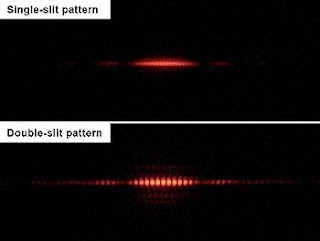Slit Inteference
Slit Interference
Imagine you were at a firing range and there was a small window for you to shoot through. You have to stand 5m away from the window and so you stand back from it and start shooting through it. If there was a screen on the other side of the window and you went to see where your bullets were landing on the screen, you would see a cluster that was in line with the window.
If you added a second window and fired randomly you would see two clusters of bullets. There would be one cluster which was in the same position as when you had one window, and there would be an additional one in line with the second window.
If you added a second window and fired randomly you would see two clusters of bullets. There would be one cluster which was in the same position as when you had one window, and there would be an additional one in line with the second window.
This is what Young's double slit experiment is except photons were used for bullets and slits were used for windows. The weird thing about this is that instead of getting two bright areas where most of the photons land, you get a weird diffraction pattern.
Areas that were previously bright when there was one slit somehow become dark when there are two slits...
This is like adding the second window to the firing range and that somehow not letting you hit areas that were previously being hit when there was only one window...
The way to explain this is to say light is a wave. If we say light is a wave, then we can say the waves diffract when they reach the slits. This means interference can occur between the waves diffracting from each slit. Bright areas are where two wave peaks have met and this is called constructive interference. Dark areas are where one wave peak has met a trough and this is called destructive interference because the wave amplitudes cancel out to 0.
But light is not a wave? It comes in discrete packets called photons?
If we look logically, the photon can either go through slit 1, slit 2, both slits or no slits. Let's look at these options and try to eliminate some so we can understand what is going on.
One Slit
It doesn't go through slit one because if we block slit 2 and only allow light through slit one, we just get a normal cluster of light. The same argument can me made for it going through slit 2 and so it must go through both slits or no slits.
Both Slits?
We've never seen half a photon so both slits seems a bit ridiculous. In 1987 an experiment was performed which would hint at which slit the photon would pass and so we can eliminate the both slits option.
That leaves us with one more option.
No Slits?!
The photon definitely does not go through no slits. If we put a barrier on both paths then we would see no light on our screen.
Intuition and classical physics can not describe how the photon has moved and so quantum mechanics is used to describe the new way objects can travel. The photon has travelled in a superposition.
The slit experiment has been done with other objects of sizes ranging from the electron to bucky-balls. If you actually try to measure which slit the which the object goes through directly, something very strange happens. Remember that for a photon p = h/λ? This means if you use a short enough wavelength of light to detect which slit the object is going through, the experiment is disturbed too much and the pattern disappears. If you increase the λ to one which does not disturb the experiment, then it is impossible to tell which slit the object went through.
This again shows that the uncertainty principle is fundamental to physics and limits the amount of information available in a quantum system.
The main point of this post was as a lead up to my post tomorrow where I will be showing how slit interference can be described mathematically.
Thanks for reading. If you enjoyed this post or any of my others, follow and subscribe to my blog. Feel free to discuss anything related to this post or ask questions in the comments below.
Check Out My Other Posts On Quantum Mechanics (link to all posts)
The Position Operator
Polarization At An Arbitrary Angle
Operators In Quantum Mechanics
Mathematical Description Of Polarization
The Birth Of Quantum Mechanics - The Ultraviolet Catastrophe
Schrödinger’s Kittens - The Boundary Between Quantum And Classical Mechanics
Did you see my previous post? Click the link below to check it out

Comments
Post a Comment